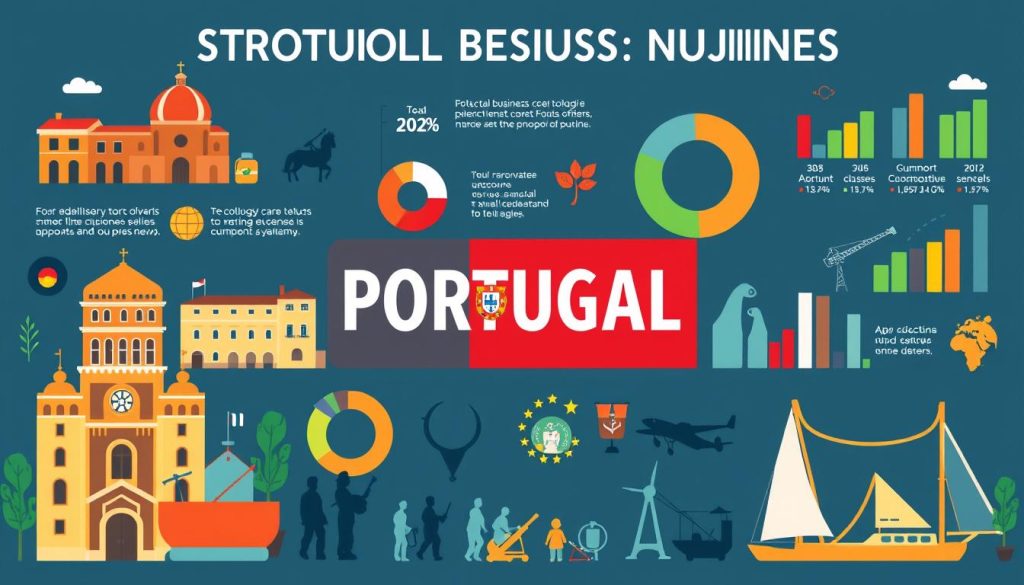In today’s fast-changing economy, knowing about structural business statistics in Portugal is key. These stats give us vital data to understand how businesses perform in different sectors. By looking at business structures in Portugal, we see how they fit into the EU’s bigger picture.
These statistics help shape government policies and show us how businesses create wealth. They are crucial for spotting trends and opportunities in the business world. By diving deeper, we’ll find out how different sectors help Portugal’s economy grow.
Understanding Structural Business Statistics: A Crucial Tool for Economic Analysis
Structural business statistics are key for deep economic analysis. They help us see how different sectors perform. This lets us track trends and make smart predictions.
By looking at data from the NACE level, we learn about wealth and job use in various sectors. This is especially true when comparing small and big businesses.
Having good EU data is crucial. In 2022, the business sector made up about 63% of GDP in the OECD. Yet, micro-firms, making up over 90% of businesses, are often missing from key data. This means we might not fully understand the business world.
About 60% of firms keep growing over time. Between 26% and 35% even grow again. So, these statistics help us keep track of these changes.
The OECD’s Trade by Enterprise Characteristics database adds more value. It combines trade data with business info. This shows how different businesses perform in exports.
In the EU, real estate saw big growth in 2021. Over 1.5 million firms were in this sector, up 11.3% from the year before. This data shows the importance of tracking sector trends.

In short, structural business statistics are vital for economic analysis. They help us understand how sectors perform. This detailed data helps in making better policies and decisions.
Key Insights from Structural Business Statistics in Portugal
Looking at the statistics, we see important trends in SBS Portugal. In 2021, the EU saw a 10.70% rate of new businesses starting. Portugal’s regions, especially, showed rates over 12.00%, showing a lively start-up scene.
The service sector is big in Portugal, making up 80.4% of all businesses. This matches EU trends, showing services are key for jobs. Wholesale, retail, and professional services are big, helping with jobs and growth.
The accommodation sector has lower costs than finance and insurance. This shows different levels of success and efficiency in businesses. Knowing this helps us understand the economy better and predict growth. We aim to share these insights to help everyone understand SBS Portugal’s changes.

Structural Business Statistics in Portugal: Industry Overview
Understanding the industry overview through structural business statistics is key to knowing Portugal’s economy. The sector contribution changes a lot across different areas, affecting our economy’s dynamics. We see how different industries impact productivity and jobs.
Contribution of Different Sectors to the Business Economy
Portugal’s various economic sectors are crucial for boosting productivity. In 2019, Portugal’s productivity per worker was 26,500 euros, which is low compared to EU countries. The trade sector led with a big increase in gross value added (GVA), up over 18% despite a small drop in jobs. The manufacturing sector also saw a GVA rise of about 25%, with an 8% increase in jobs.
- The manufacturing sector greatly contributed to the economy, showing a strong positive trend.
- Micro, small, and medium-sized enterprises (MSMEs) made up 66% of total employment, showing their vital role in the economy.
- More than 95% of the workforce was in sectors with better productivity.
Employment Statistics Across Various Industries
Looking at employment statistics shows how our workforce allocation affects productivity. The services sector leads in employment in Portugal, but there’s a trend. High-value sectors like professional and scientific activities are growing. This is different from sectors like accommodation and food services, which are growing slower.
- Employment in the ICT sector grew from 2.5% in 2010 to 3.5% in 2019.
- MSMEs play a big role in many sectors, especially in trade and manufacturing.
- Reducing the productivity gap could mean a big boost to GDP, like a 4.4% increase.
The Role of SMEs in Portugal’s Economic Landscape
In Portugal, Small and Medium-sized Enterprises (SMEs) are key to our economy. They make up 99.8% of all businesses. These firms add a lot of value to our economy and help us stay strong during tough times.
It’s important to know how SMEs work and why they matter. They help bring new ideas and encourage more people to start their own businesses.
Importance of Small and Medium-Sized Enterprises
SMEs are vital for jobs in our economy. They employ about 63.4% of the workforce. This shows how important they are for creating jobs and keeping the economy stable.
Supporting SMEs can help our economy grow. It can also make our job market stronger across Portugal.
SMEs’ Contribution to Employment and Value Added
SMEs in Portugal also create a lot of value, about 50.2% of the total. They play a big role in making our economy productive and wealthy.
But, SMEs face challenges like finding money and competing in the market. We need to help them get better funding and create a good business environment. This will help them grow and keep our economy strong.

